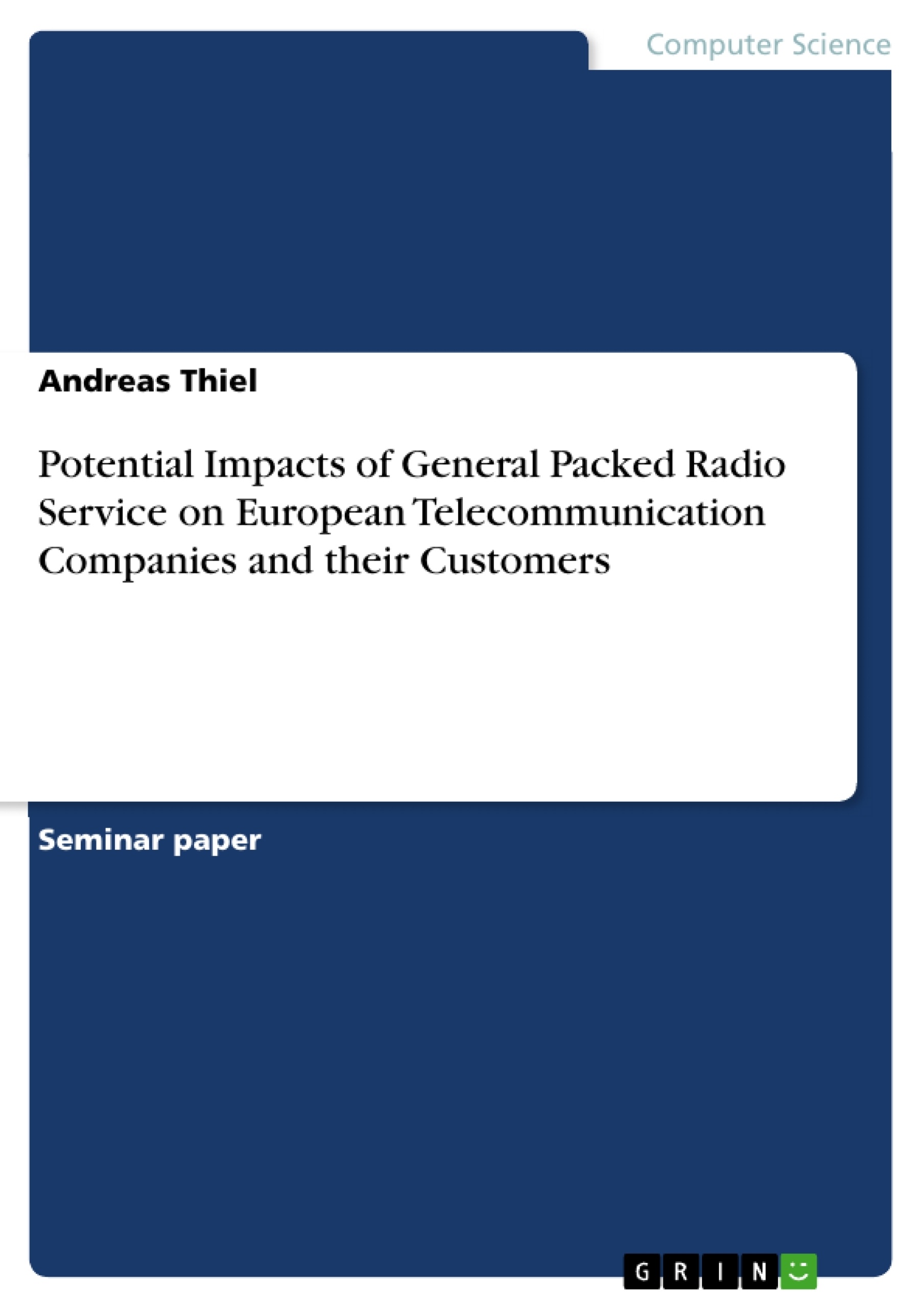1 Introduction
1.1 GPRS, the first Step towards unlimited Communication?
“46.8 percent of Europeans owned a mobile phone in 2000” (Hobley, 2001, p. 6). Since this high penetration was achieved in a relatively short time period, nearly all telecommunication companies showed huge growth rates. This applied for mobile operators, telecommunication network suppliers as well as for mobile phone producers and went in line with skyrocketing share prices. Since mobile phone penetration was already very high, telecom companies’ growth rates shrank dramatically over the last year and share prices fell according to that. Consequently, telecom companies had to invent new gadgets to encourage people to buy new mobile phones and sign new contracts with mobile operators. Therefore, research concentrated on greater bandwidth in order to widen the functionality of mobile phones and to increase usage time. Telecom companies have the vision that sooner or later everybody will use a mobile phone not only to call other people, but also to access the Internet from everywhere and at any time. These “multimedia entertainment and information terminals” (Berton, 2001, p. 18) would lead to increased data traffic and, therefore, higher revenues for mobile operators. Furthermore, constant improvements of infrastructure and mobile devices would ensure further sales for network suppliers and mobile phone manufacturers. General Packed Radio Service (GPRS) is considered to be the first step in that direction, which will be followed by Universal Mobile Telecommunications System (UMTS).
Inhaltsverzeichnis (Table of Contents)
- Introduction
- GPRS, the first Step towards unlimited Communication?
- Procedure and Analysis Objectives
- What is General Packed Radio Service?
- Positive and Negative Impacts of GPRS
- Potential Impacts on End Users
- Positive Impacts
- Negative Impacts
- Potential Impacts on Mobile Operators
- Positive Impacts
- Negative Impacts
- Potential Impacts on Handset Producers and Network Suppliers
- Positive Impacts
- Negative Impacts
- Evaluation of Strengths and Weaknesses of GPRS
- Strengths of GPRS
- Weaknesses of GPRS
- Possible Solutions to Overcome the Shortcomings of GPRS
- Inconvenient Mobile Devices for Wireless Applications
- Fixed Networks Superiority and Threat of WLANS
- Lack of Interest in GPRS Compared to UMTS
- Outdated WAP Standard
Zielsetzung und Themenschwerpunkte (Objectives and Key Themes)
The main objective of this report is to analyse the potential impacts of General Packed Radio Service (GPRS) on European telecommunication companies and their customers. The report will explore the implications of GPRS for mobile phone producers, network suppliers, mobile operators, and end users.
- Impacts of GPRS on different stakeholders (end users, mobile operators, handset producers and network suppliers)
- Strengths and weaknesses of GPRS technology
- Potential solutions to overcome the shortcomings of GPRS
- The European telecommunications market and its reliance on GSM technology
- The role of GPRS as a stepping stone towards the future of mobile communication
Zusammenfassung der Kapitel (Chapter Summaries)
- Introduction: This chapter provides a brief overview of GPRS and its potential to revolutionize mobile communication. It highlights the rapid growth of the mobile phone market in Europe and the need for telecom companies to develop new technologies to sustain this growth. GPRS is presented as a key development in this direction, offering increased bandwidth and broader functionality for mobile devices.
- What is General Packed Radio Service?: This chapter offers a detailed explanation of GPRS technology, highlighting its core features and how it enhances the GSM system. The chapter explains the key advantages of GPRS, such as its ability to handle continuous data flows and its efficient use of network capacity.
- Positive and Negative Impacts of GPRS: This chapter examines the potential impacts of GPRS on various stakeholders, including end users, mobile operators, handset producers, and network suppliers. It discusses the potential benefits and challenges associated with GPRS for each stakeholder group.
- Evaluation of Strengths and Weaknesses of GPRS: This chapter evaluates the strengths and weaknesses of GPRS technology. It explores the advantages of GPRS, such as its potential for increased data transfer speeds and enhanced user experience. However, it also identifies several limitations, including the lack of widespread handset compatibility and the potential for network congestion.
- Possible Solutions to Overcome the Shortcomings of GPRS: This chapter explores potential solutions to address the shortcomings of GPRS. It discusses strategies to overcome challenges such as the lack of convenient mobile devices for wireless applications, the superiority of fixed networks, the lack of interest in GPRS compared to UMTS, and the outdated WAP standard.
Schlüsselwörter (Keywords)
Key terms and concepts covered in this report include: General Packed Radio Service (GPRS), Universal Mobile Telecommunications System (UMTS), Global System for Mobile Communications (GSM), data transfer speeds, bandwidth, mobile phone penetration, telecommunication companies, network suppliers, handset producers, end users, mobile operators, European telecommunications market, and wireless communications.
- Arbeit zitieren
- Andreas Thiel (Autor:in), 2001, Potential Impacts of General Packed Radio Service on European Telecommunication Companies and their Customers, München, GRIN Verlag, https://www.grin.com/document/9184



